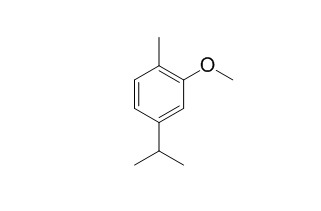Carvacrol methyl ether
Carvacrol methyl ether has antimicrobial, and antioxidant activities.
Inquire / Order:
manager@chemfaces.com
Technical Inquiries:
service@chemfaces.com
Tel:
+86-27-84237783
Fax:
+86-27-84254680
Address:
1 Building, No. 83, CheCheng Rd., Wuhan Economic and Technological Development Zone, Wuhan, Hubei 430056, PRC
Providing storage is as stated on the product vial and the vial is kept tightly sealed, the product can be stored for up to
24 months(2-8C).
Wherever possible, you should prepare and use solutions on the same day. However, if you need to make up stock solutions in advance, we recommend that you store the solution as aliquots in tightly sealed vials at -20C. Generally, these will be useable for up to two weeks. Before use, and prior to opening the vial we recommend that you allow your product to equilibrate to room temperature for at least 1 hour.
Need more advice on solubility, usage and handling? Please email to: service@chemfaces.com
The packaging of the product may have turned upside down during transportation, resulting in the natural compounds adhering to the neck or cap of the vial. take the vial out of its packaging and gently shake to let the compounds fall to the bottom of the vial. for liquid products, centrifuge at 200-500 RPM to gather the liquid at the bottom of the vial. try to avoid loss or contamination during handling.
FEMS Microbiol Lett.2017, 364(11)
Sci Rep.2024, 14(1):23786.
Appl. Sci. 2024, 14(13), 5815
LWT2024, 200:116184.
Phytother Res.2022, 35844057.
Molecules.2019, 24(4):E744
J Vet Sci.2020, 21(3):e39.
JPC-Journal of Planar Chromatography2023, 36:179-190
Plos One.2020, 10.1371
Microchemical Journal2018, 137:168-173
Related and Featured Products
Letters in Applied Microbiology 43(2):149-54.
Antimicrobial activity of carvacrol related to its chemical structure.[Reference:
WebLink]
To investigate the relation between the chemical structure and the antimicrobial activity of carvacrol, eugenol, menthol and two synthesized carvacrol derivative compounds: Carvacrol methyl ether and carvacryl acetate against bacteria, Escherichia coli, Pseudomonas fluorescens, Staphylococcus aureus, Lactobacillus plantarum, Bacillus subtilis, a yeast Saccharomyces cerevisiae and one fungi Botrytis cinerea.
METHODS AND RESULTS:
The antimicrobial activity was tested in liquid and vapour phases, by both broth liquid and microatmosphere methods, respectively. The same classification of the compound's antimicrobial efficiency was found with both methods. Eugenol and menthol exhibited a weaker antimicrobial activity than carvacrol, the most hydrophobic compound. Carvacryl acetate and Carvacrol methyl ether were not efficient, indicating that the presence of a free hydroxyl group is essential for antimicrobial activity. The different extents of antimicrobial aroma compounds' efficiency showed that hydrophobicity is an important factor and the presence of a free hydroxyl group and a delocalized system allows proton exchange.
CONCLUSIONS:
This study has identified the importance of the hydrophobicity and the chemical structure of phenolic aroma compounds for antimicrobial activity and may contribute to a most rational use of these compounds as antimicrobial agent.
Free Radical Research,2003, 37(6):673-679.
Chemical composition and in vitro evaluation of antioxidant effect of free volatile compounds from Satureja montana L.[Reference:
WebLink]
As a part of an investigation of natural antioxidants from Dalmatian aromatic plants, in this paper we report a study of the antioxidant activity related to the chemical composition of savory free volatile compounds.
METHODS AND RESULTS:
Twenty-one compounds were identified in the essential oil without fractionation, representing 97.4% of the total oil. The major compound was phenolic monoterpene thymol (45.2%). Other important compounds were monoterpenic hydrocarbons p-cymene (6.4%) a nd gamma-terpinene (5.9%)and oxygen-containing compounds Carvacrol methyl ether (5.8%), thymol methyl ether (5.1%), carvacrol (5.3%), geraniol (5.0%) and borneol (3.9%). The evaluation of antioxidant power was performed in vitro by the beta-carotene bleaching and thiobarbituric acid (TBA) methods. As determined with both methods, the total savory essential oil as well as different fractions or pure constituents containing hydroxyl group exhibited relatively strong antioxidant effect.
CONCLUSIONS:
The hydrocarbons, when isolated as CH fraction, showed the poorest effectiveness in spite the fact that this fraction contained gamma-terpinene, alpha-terpinene, p-cymene and terpinolene which previously were identified as potential antioxidants.



